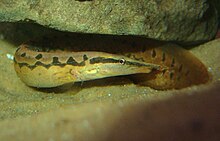| Zig-zag eel | |
|---|---|

| |
| Scientific classification | |
| Domain: | Eukaryota |
| Kingdom: | Animalia |
| Phylum: | Chordata |
| Class: | Actinopterygii |
| Order: | Synbranchiformes |
| Family: | Mastacembelidae |
| Genus: | Mastacembelus |
| Species: | M. armatus
|
| Binomial name | |
| Mastacembelus armatus (Lacepède, 1800)
| |
| Synonyms[2] | |
| |
The zig-zag eel (Mastacembelus armatus Scopoli, 1777[3]), also known as the Baim[4],tire-track, tire-track spiny- eel, freshwater spiny eel, or marbled spiny eel,[2] is a species of freshwater ray-finned fish in the family Mastacembelidae. It is native to the riverine systems of the Indian Subcontinent (India, Bangladesh, Pakistan, Nepal), Sri Lanka, South China, Malaysia,Thailand, Vietnam, Cambodia, Indonesia, and other parts of South and Southeast Asia. The species was initially described as Macrognathus armature (Lacepède, 1800).[5] Other common names for this popular captive species include the leopard spiny eel[6] and white-spotted spiny eel.
This eel has remained fairly popular as an aquarium fish for years, owing to its unique appearance and behaviors. Additionally, like other species of eels throughout the world, the zig-zag eel serves as a viable protein and food source for humans, aquatic reptiles, birds and other, larger fishes throughout much of its range.[7][2] As a food source, zig-zag eels are consumed locally along the rivers they inhabit and are prepared in various ways including, smoked, barbecued, fried, curried, pickled, and dried. In traditional medicinal practices in Punjab, the oral ingestion of the meat and topical application of the skin and oil of the fish is used as a treatment for muscle soreness.[8]
- ^ Fernado, M.; Kotagama, O.; de Alwis Goonatilake, S. (2019). "Mastacembelus armatus". IUCN Red List of Threatened Species. 2019: e.T166586A60592409. doi:10.2305/IUCN.UK.2019-3.RLTS.T166586A60592409.en. Retrieved 19 November 2021.
- ^ a b c Froese, Rainer; Pauly, Daniel (eds.). "Mastacembelus armatus". FishBase. August 2019 version.
- ^ Integrated Taxonomic Information System, National Museum of Natural History, Washington, D.C., Mastacembelus armatus (Lacepède, 1800), Taxonomic Serial No.: 172692, 2007, retrieved on:5 June 2007.
- ^ "তারাবাইম রেগুলার সাইজ ১ কেজি". Retrieved 14 September 2024.
- ^ Eschmeyer, William N.; Fricke, Ron & van der Laan, Richard (eds.). "'Macrognathus armatus". Catalog of Fishes. California Academy of Sciences. Retrieved 13 November 2019.
- ^ Leopard spiny eel (Mastacembelus armatus), BangkokAquarium.com, Bangkok, Thailand, 2006, retrieved on: 5 June 2007.
- ^ Butler, Rhett Ayers, Tire track Eel, Spiny Eel, White-spotted Spiny Eel (Mastacembelus armatus), Tropical Freshwater Aquarium Fish (TFAF), 1995 and Mongabay.com, 2006, retrieved on: 5 June 2007.
- ^ Iqbal, Khalid Javed; Umair, Muhammad; Altaf, Muhammad; Hussain, Tanveer; Ahmad, Rana Manzoor; Abdeen, Sayed Muhammad Zain Ul; Pieroni, Andrea; Abbasi, Arshad Mahmood; Ali, Shahzad; Ashraf, Sana; Amjad, Naila; Khan, Abdul Majid; Bussmann, Rainer W. (9 January 2023). "Cross-cultural diversity analysis: traditional knowledge and uses of freshwater fish species by indigenous peoples of southern Punjab, Pakistan". Journal of Ethnobiology and Ethnomedicine. 19 (1). doi:10.1186/s13002-022-00573-1. ISSN 1746-4269. PMC 9827695. PMID 36624457.
